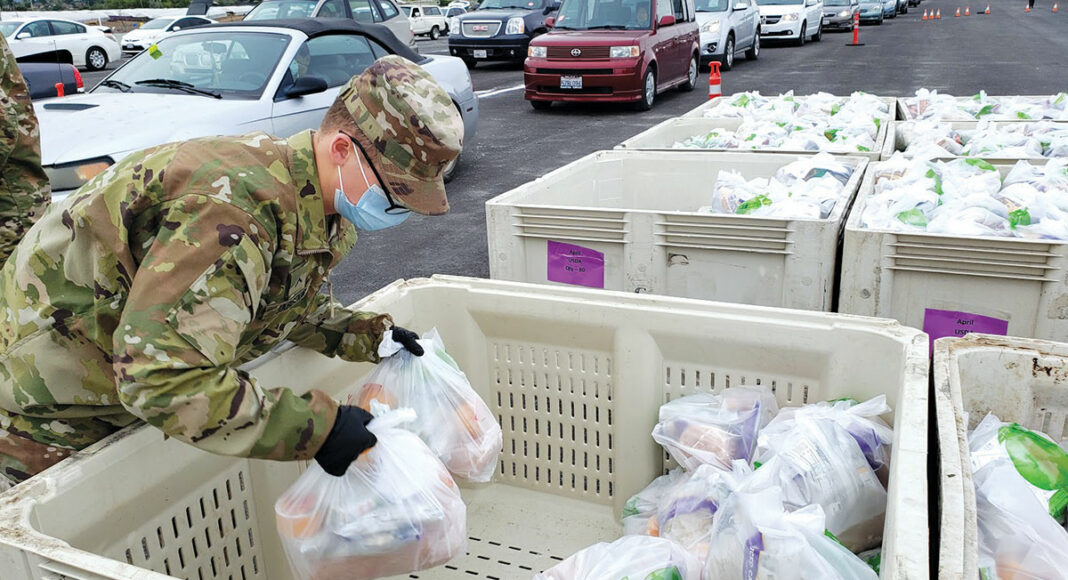By Wallace Baine and Jennifer Cain
William Avery’s home is not easy to find. Situated on a densely wooded site along the San Lorenzo River near Boulder Creek, Avery’s home may sound remote enough to be ideal for hiding from a rapidly spreading dangerous virus. But it’s also a test of patience and hunting skills for delivery drivers.
Still, Meals on Wheels (MOW) is up to the challenge. Avery and his roommate are both seniors, vulnerable to COVID-19, and in particular need for the program that delivers ready-made meals door to door throughout Santa Cruz County.
“You can see the relief in their eyes when they realize they’ve found us,” laughs Avery, 80, of the MOW drivers that deliver to his home. Avery struggles daily from the aftereffects of a car accident eight years ago that severely impaired his mobility. His older roommate has suffered a series of strokes. Yet, before the pandemic crisis emerged, the two men would regularly go into town for their supplies.
Now, of course, it’s a different story. The elderly and medically vulnerable are at particular risk for the virus, and Avery isn’t taking any chances. “They’re telling us that we have that ‘X’ on our backs,” he says. “So we’re just not going out.”
That kind of self-sequestering just would not be possible without programs like Meals on Wheels. “It may be saving our lives, if you want to look at it that way,” Avery says.
Programs that deliver food to the most vulnerable, like MOW, Second Harvest Food Bank and Grey Bears, have seen an enormous spike in demand in recent weeks.
Raymon Cancino, the CEO of Community Bridges, the nonprofit that administers the MOW program, says demand has increased by 40% since the shelter-in-place order.
The increase in demand has had a ripple effect in the program, as it has redirected staff and volunteers to do more deliveries and has also had to increase its capacity for storage. Cancino says that MOW has recently spent $20,000 on extra refrigeration.
Meals on Wheels delivers free complete meals daily to seniors age 60 and over and people with disabilities. The frozen meals, shipped in from southern California, are “good sound food, prepared well, and with reasonable variety,” Avery says.
Cancino says the program aims to increase its output to two meals a day to those who need them. And though the program has benefitted from about 200 individual donations and an increase in support from the state, MOW still needs funding to cover the cost of its increased capacity.
GREY OF HOPE
Both MOW and Grey Bears serve mostly in Santa Cruz County, with some clients in San Benito and Monterey counties. But, while MOW delivers ready-made meals daily, Grey Bears puts together a large bag of fresh produce and bread for its clientele, delivered every week, with an emphasis on fresh produce, bread, rice, and soup stock ingredients. Grey Bears executive director Tim Brattan calls Meals on Wheels “a great service.”
“And I think we really complement each other,” he says.
Grey Bears delivers most of its food to various pick-up sites across the county, but also services about 1,000 seniors with door-to-door delivery. Brattan says that his organization has also seen a dramatic spike in demand in the last two months. “We’re right around the historical high point,” says Brattan, who came to Grey Bears a decade ago at another peak moment, in the wake of the 2008-09 recession.
Grey Bears gets about half of its food donations from food banks in Santa Cruz and Monterey counties. Most of the rest the organization has to buy. That means, though Grey Bears is flush with volunteers at the moment, it could always use monetary donations.
“One day, we had about 500 calls,” Brattan says. “We couldn’t even answer them all. They were people just wanting to know about the program and ‘How can I sign up?’”
NEED A SECOND
In response to increasing food insecurity, Second Harvest Food Bank Santa Cruz County has been hosting drive-thru distributions with help from the National Guard at the Santa Cruz County Fairgrounds. On April 17, in its fourth drive-thru event since the pandemic began, the food bank served over 3,000 families, with each family getting their own batches of groceries.
Prior to the spread of COVID-19, the Second Harvest Food Bank served 55,000 individuals a month. Now, it serves between 70,000 and 80,000 individuals a month, says Suzanne Willis, the chief development and marketing officer at Second Harvest.
Much of the produce is from growers in the Pajaro Valley, and the USDA also makes donations. Certain products like rice are becoming more expensive to source, Willis says, partly due to increased demand at grocery stores. “Things like bread—we are just not getting that right now,” Willis says.
Before the April 17 distribution gets underway at 9am, hundreds of cars start lining up at the fairgrounds at 7:45am waiting for the distribution line to open.
Ethan Jabbour, a welder and machinist in the National Guard, helps with the heavy lifting, dropping sacks of potatoes and several bags of assorted groceries into each vehicle. Jabbour says, “It’s amazing and rewarding to see how many people came,” he says.
Maria Urvieta was one of the first cars in line. She was visiting the drive-thru for her second time to feed her family of six. Before the pandemic, she operated a day care in Watsonville, where she’s lived for 30 years, but she says that children were no longer coming since all the adults were now at home. The public health officer’s shelter-in-place order has also placed new restrictions on day care centers.
“In the night, I can’t sleep, thinking and thinking,” Urvieta says. “The food bank helps a lot. The vegetables, the beans and rice help a lot.”
For more on Meals on Wheels, go to communitybridges.org/mealsonwheels. For more on Grey Bears, visit greybears.org. For information on Second Harvest, go to thefoodbank.org.













